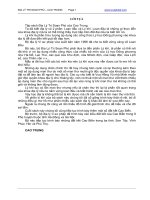Tài liệu TOP-DOWN CONSTRUCTION pdf
Bạn đang xem bản rút gọn của tài liệu. Xem và tải ngay bản đầy đủ của tài liệu tại đây (633.2 KB, 2 trang )
March 2005 Designed & produced by C2 Design Studio Pte Ltd
If you have any suggestions or feedback,
please call our Customer Service Line: 1800 – CALL LTA
1800 – 2255 582
While noise, dust and other inconveniences
are inevitable during construction, LTA will
work closely with the contractor to keep
them to a minimum.
The underground retaining wall, which is
usually a concrete diaphragm wall, is
installed before excavation commences.
Some of the underground Rapid Transit System (RTS) stations are constructed
by the “top-down” method. In this method, the underground retaining walls are
first installed. In most cases, these retaining walls are concrete diaphragm walls.
This is followed by excavation to just below the roof slab level of the underground
structure, with the retaining walls and struts supporting the soil at the sides.
The roof slab is then constructed, providing a massive support across the
excavation. Access openings on the roof slab are provided so that works thereafter
could proceed downwards to the base slab level of the underground structure.
Upon completion of the base slab, the side walls are constructed and the
intermediate struts are progressively removed. The access openings on the roof
slab are then sealed and the ground is subsequently backfilled and reinstated.
TOP-DOWN
CONSTRUCTION METHOD
Diverted
Road
Proposed
Underground
Structure
Construction Site
Hoarding
01 . Installation of
Retaining Wall
Retaining Wall
02 . Excavation &
Installation of
Steel Strut
Strut
Roof Slab to be
Constructed
The soil is excavated to just below the
roof slab level of the underground
structure. Struts are installed to support
the retaining walls, which in turn support
the soil at the sides.
03 . Construction
of Underground
Structure
The roof slab is constructed, with access
openings provided on the slab for works
to proceed downwards. The roof slab
not only provides a massive support
across the excavation, it also acts as a
noise barrier.
Strut
Roof Slab
Roof Opening
Decking
TOP-DOWN
CONSTRUCTION
04 . Construction
of Underground
Structure
Strut
Roof Slab
Decking
The next level of slab is constructed, and
this process progresses downwards till
the base slab is completed.
Strut
Roof Opening
05 . Construction
of Underground
Structure
Strut
Roof Slab
Decking
The side walls are constructed upwards,
followed by removal of the intermediate
struts. The access openings on the roof
slab are then sealed.
06 . Backfilling &
Reinstatement
Backfill
Reinstated Road
Completed
Underground
Structure
After the underground structure is
completed, the soil is backfilled to the
top strut level before the strut is removed.
This is followed by completely backfilling
the top of the underground structure and
finally reinstating the surface areas.
Base Slab
Strut
Side Walls
INSTALLATION OF RETAINING WALL
- DIAPHRAGM WALL
The following pictorial guide
illustrates the construction sequence
of a typical diaphragm wall. This type
of retaining wall was used for the
construction of Kovan Station on the
North East Line (NEL).
01 .
Construction of Guide Wall
A guide wall is constructed to set out the position of
the diaphragm wall.
The grab/trench cutter cuts and removes the soil
to form the panel. The excavation is stabilised by
filling it with bentonite slurry to support the wall
of the excavation.
02 .
Excavation of Panel
03 .
Installation of Rebar Cage
04 .
Concreting of Panel
Concrete is poured into the
panel to form the panel wall.
05.
Repetition of Process
~800 to
1000mm
~1200mm
Safety Measures
The Land Transport Authority (LTA) accords top priority to safety.
Professional Engineers (PE) and Qualified Persons (QP) are engaged
to carry out stringent checks on the temporary structures to ensure
that they are installed correctly and safely before the excavation can
proceed from one level to the next level. In addition, our engineers
monitor the various stress and strain gauges installed on the temporary
structures on a regular basis so as to be sure that the stresses fall
within acceptable limits set by the design engineers. Likewise,
instruments are extensively installed in the vicinity of the construction
site to monitor vibrations, ground movements etc. This is so that the
engineers are always in the know of the impact of the construction
on the surrounding buildings and structures, thereby ensuring that
they are safe.
The crane lifts up the reinforcement-bar cage
and places it within the panel.
Bite
No.1
Bite
No.2
Bite
No.3
Bentonite Slurry
Completed Panel
Guide Wall
Completed
Diaphragm Wall
Inconveniences
Noise is generated when the grab/trench cutter excavates the soil
as well as during the panel concreting process. As it is vital that
concrete is poured continuously into the panel till the whole panel
is completely and homogeneously filled with the concrete, it is
inevitable that work runs into the night when the panel is concreted
so as not to affect its structural integrity.
02 .
03.
04 .
01 .
Process 2 - 4 repeats for the remaining soil in
between the panels till the entire length of the
diaphragm wall construction is completed.
Moving Off
Rebar Cage
Concrete
Panel Wall
Concreting Pipe









